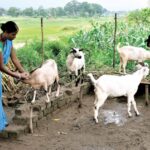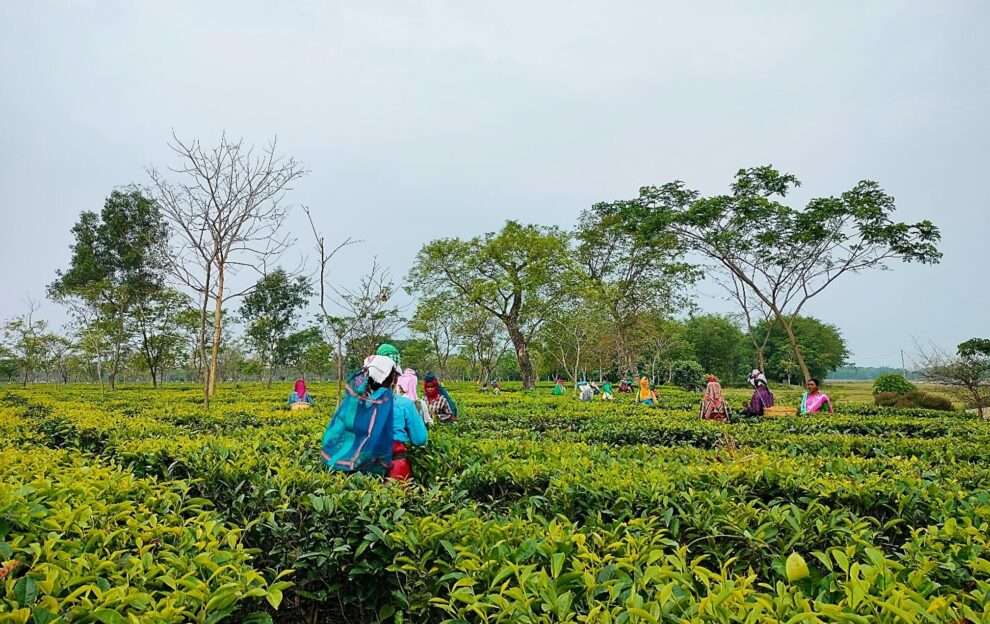Small tea growers are important stakeholders in the tea industry. In this blog, Swarup Upadhyaya explores the diverse challenges faced by Small Tea Growers (STGs) in Assam, the organisations that support them, and potential solutions for their sustainable growth.
CONTEXT
The tea industry provides employment to approximately 2.29 lakh small tea growers (STGs) across the country, including 1.22 lakh in Assam alone. According to reports from the Tea Board of India, the total area under tea cultivation in Assam spans 3.12 lacs hectares, of which 1.14 lacs hectares (approximately 36.78%) are managed by STGs (Box 1). STGs in India comprise of tea plantation owners with an area under plantation less than 10.12 hectares. They sell the green tea leaves either through the green leaf agents or directly to the Bought Leaf Factories (BLF). In terms of production, Assam contributes around 715 million kilograms of tea, with over 50% of this output coming from STGs. Notably, the easternmost districts of Assam—Tinsukia and Dibrugarh—have the highest concentration of small tea growers.
|
Box 1: Origin of Small Tea Cultivation Chabua Tea Estate (the first tea estate in Assam, now under Amalgamated Plantations Pvt. Ltd.) was established in 1836. Almost one and a half centuries later, in 1978, the then Minister of Agriculture and Cooperatives of Assam, Mr. Someshwar Bora (also known as the father of small tea growers), announced that small tea plantations could be carried out at small levels. And then, towards the end of the 20th century, tea became a popularly grown farmer’s crop in Assam. |
CHALLENGES FACED BY STGs
STGs currently face a number of challenges in terms of technical know-how, economic conditions, and climate change. These are discussed in detail below:
Technical Challenges
Limited training and reliance on informal knowledge leave small tea growers struggling to adopt best practices. While research organisations offer various study materials, such as calendars detailing farm activities, these are often disregarded due to a strong attachment to traditional methods. This hinders efforts by technical experts to introduce new techniques. Furthermore, many growers lack awareness of regulations regarding safe chemical use, leading to potential environmental and health risks. The technical gaps manifest in several ways. An improper pruning technique, with incorrect heights and cycles, reduces overall productivity. Difficulty identifying and applying the right dosage of chemicals further compounds the issue. Young tea management practices are often neglected, further hindering bush development. Finally, reliance on readily available planting materials instead of recommended varieties suited to specific regions can leave crops vulnerable to local pests and diseases. These knowledge gaps extend to post-climate adversity practices, leaving crops susceptible to permanent damage from diseases like red root. Moreover, small tea growers are unprepared for the upcoming rejuvenation of their tea bushes.
Economic Challenges
Though the small tea gardens have improved the socio-economic condition of STGs in many areas, the current economic situation remains a cause for concern. One of the primary factors contributing to this is the fluctuating price of green tea leaves. After plucking, tea leaves become highly perishable and are promptly sent to BLFs on the same day. Unfortunately, BLFs hold significant decision-making power over prices, leaving growers with little room for negotiation. Consequently, during peak production seasons, tea leaf prices tend to be lower. The net income of a small tea grower is only around 2.63 per kg.
Additionally, tea prices have not shown an increasing trend compared to inflation in other input commodities like pesticides and fertilizers. Many tea growers lack proper records of their incomes and expenditures. Instead, they rely on local agents’ records, often providing tentative answers when questioned. This negligence has serious consequences, including the deprivation of financial assistance from institutions such as banks.
Climate Change
The unpredictable rainfall patterns (leading to water logging) and occasional prolonged dry spells harm the tea plants. Additionally, temperatures exceeding 37 °C reduce the photosynthetic rate in these plants. While growers are aware of these challenges, they traditionally rely on windbreaks created by planting bamboo and shade trees. Unfortunately, small tea growers lack irrigation facilities (irrigation facilities for the small tea gardens of the northern Brahmaputra valley are a need of the hour), and essential instruments like wind gauges and thermometers are absent in their gardens. As a result, small tea growers remain the most vulnerable group.
Tea gardens serve as significant carbon sinks, capturing and storing carbon dioxide from the atmosphere. The Tea Research Association has even signed a memorandum of understanding (MoU) with Boomitra to provide carbon credit to its member gardens. While larger estates are well-informed about the global climate finance landscape, small tea growers remain unaware of this situation. Providing proper training on regenerative agriculture and carbon farming in tea is essential for these growers to enhance their understanding of sustainable practices.
Every 9th cup of tea sipped anywhere in the world is from the lush gardens of Assam
(Government of Assam, 2020)
SUPPORTING STGS
A number of organisations exist to support STGs. At the national level, the Tea Board of India is the nodal statutory body for the cultivation of tea in India (Box 2).
|
Box 2: Tea Board of India (TBI) |
At the state level, the Assam Agricultural University (AAU) has been a hub for small tea plantations, providing essential technical guidance and mentorship. The Department of Tea Husbandry and Technology plays a pivotal role in the tea sector by offering education through undergraduate, diploma, postgraduate, and Ph.D. courses. This ensures a steady supply of well-trained manpower with expertise in tea cultivation for the tea industry. The department has a Small Tea Growers Advisory Programme and other initiatives sponsored by the Tea Board, under which they conduct training sessions for small tea growers across various districts in Assam. In 2023, AAU established the Citrus and Plantation Crop Research Institute, focusing on research related to tea and other plantation crops. Additionally, the Krishi Vigyan Kendras (Farm Science Centres) of the university actively assist small tea growers by organising training sessions on disease and pest management, organic cultivation of teas, etc. AAU also conducts a Tea Industrial Work Experience Programme for B.Sc. Agriculture Students (Box 3).

TIWEP students perform a method demonstration in a small tea garden during the collection of soil samples
|
Box 3: Tea Industrial Work Experience Programme (TIWEP) |
Apart from TBI and AAU, several other stakeholders also provide support to STGs. The roles played by these stakeholders are discussed in Table 1.
Table 1: Roles played by other stakeholders in the Smallholder Tea Sector
| S. No. | Stakeholders | Roles played to support STGs |
| 1. | Tea Directorate, | The Directorate of Tea’s mission is to facilitate and accelerate the inclusive growth of all small tea growers in Assam while ensuring the well-being of marginalised tea workers and fostering financial empowerment through critical financial support. By promoting quality enhancement and best practices, the Directorate strives to elevate the entire Assam tea industry to a position of global leadership, securing Assam’s cherished tea legacy for generations to come. It also facilitates the establishment of BLFs managed by Self-Help Groups (SHGs) of small tea growers. |
| 2. | The Confederation of Indian Small Tea Growers’ Associations (CISTA) | CISTA is a confederation of 11 state small tea growers’ associations. It represents small tea growers at the national level. |
| 3. | All Assam Small Tea Growers Association (AASTGA) | AASTGA, established in 1987, is an organisation that represents the small tea growers in Assam. It’s a constituent organisation of CISTA. |
| 4. | Assam Bought Leaf Tea Factories and Manufacturer’s Association (ABLTMA) | ABLTMA represents the factories that buy tea leaves from small tea growers through their agents. |
| 5. | Input Dealers | These are the dealers of agricultural inputs to the tea growers. |
| 6. | Tocklai Tea Research Institute | The Tocklai Tea Research Institute, in association with the Government of Assam, has launched the Small Tea Growers Advisory Programme. Through this initiative, farmers receive technical guidance from the century-old tea research establishment, with a particular focus on organic tea cultivation. The programme includes publications in vernacular languages, a month-wise checklist of cultural practices, etc.
T-Labs, the network of tea laboratories, has also collaborated with the government of Assam to provide green testing services to the small tea growers in Assam. |
| 7. | TRINITEA | TRINITEA is a joint initiative between Solidaridad Asia and the Indian Tea Association. Their focus is on the overall development of growers, helping them adapt sustainable practices, providing technical guidance, and supporting supply chain linkages between growers and factories. The programme is actively involved with more than 72,000 farmers. Training sessions are organised for small tea growers by industrial experts, emphasising effective utilisation of the ‘plant protection code’ and optimising input usage. These sessions connect with small growers through physical and digital meetings, bulletins, and other channels. The TRINITEA programme aims to create a transparent supply chain for tea, connecting growers directly with consumers. Consumers can engage with producers or farmers, fostering a direct and informed connection. |
| 8. | TRUSTEA | TRUSTEA is governed by the TRUSTEA Sustainable Tea Foundation, which is represented by Tata Consumer Products Ltd., Hindustan Unilever Limited, Wagh Bakri Tea Group, and IDH. The programme aims to transform the industry for the benefit of all stakeholders, including the environment. Currently, approximately 81,347 small tea growers are associated with TRUSTEA. The programme verifies tea producers against a comprehensive code of conduct. In the tea sector, TRUSTEA focuses on improving food safety, pest and disease control, worker welfare, small-scale tea farmers, and biodiversity conservation. |
| 9. | Agricultural and Processed Food Export Development Authority (APEDA) | APEDA is the export development authority that certifies organic small tea growers under the National Programme for Organic Production. |
| 10. | National Bank for Agricultural and Rural Development (NABARD) | NABARD is an apex institution in the rural credit structure. It plays a role in encouraging tea growers by financing the bankers who provide loans to the growers. |
| 11. | North Eastern Development Finance Corporation (NEDFI) | NEDFI is a financial institute that provides loans (at an interest rate of 7%) to eligible entrepreneurs in Assam for the development of specialty tea production units. |
The small tea sector, even with these varied actors, faces a diverse set of challenges. This is mainly because most of these actors do not directly reach the small tea growers. There is no proper monitoring and evaluation for extension activities that are being carried out by any of the above organizations. There is also a shortage of funds for conducting research. Moreover, the market also faces an oversupply of tea currently.
THE WAY FORWARD
Among all the challenges faced by STGs, economic challenges are the most serious, affecting the overall income of the growers. The price of green tea leaves supplied by them to BLFs hasn’t gone up considering the increase in production costs. The growers have been requesting the government fix a Minimum Support Price (MSP) for green tea leaves, which is perhaps the best way to address the issue of falling prices.
The government should also consider a mission-mode project to support STGs in production, processing, branding, marketing, and export of their teas with clearly defined objectives, scope, implementation timelines, measurable outcomes, and service levels. In Assam, the Tea Directorate can facilitate the formation of cooperatives among small tea growers. These cooperatives can then handle the processing, marketing, and branding of tea produced by their members. As the tea is under the Ministry of Commerce, STGs are deprived of the benefits provided by the Ministry of Agriculture and Farmer’s Welfare to the farmers. This needs to be addressed.
The productivity of tea gardens in small holdings has reportedly been declining. This is either due to climate change or due to ageing tea bushes. The aged, unproductive bushes should be removed after 35-40 years. But though uprooting and replanting are necessary, it results in a seven-year period without income for small tea growers. The Tea Board should provide financial assistance during this crucial period, with a special focus on growers with landholdings that are less than 1 hectare, because these growers will be the most affected.
There is a need to significantly increase the technical knowledge of STGs to enhance the productivity and quality of tea. Technical awareness can be enhanced through dedicated research and extension services for the tea and plantation sectors. As directly reaching about 2.5 lakh STGs is not possible with the existing staff available to all stakeholders, there is a need to develop a cadre of para-extension workers to reach all STGs. Besides the para-extension workers, Kishan Call Centres must also be popularised amongst the farmers. The students in their post-graduation and final year of under graduation can be associated with the Call Centres. This would provide manpower for the call centres, and the students would gain an understanding of the real-time problems faced by the farmers in the sector.
On the part of the growers, they lack the habit of recording financial transactions. This makes it very hard for extension workers to understand the balance sheet of each individual holding. Providing a model of farm records would help understand the cost of production as well as the net returns of cultivation. This would also aid them in making effective decisions.
To address climate change, farmers need access to a weather-based crop insurance scheme and the benefits of the PM Krishi Sinchayi Yojana (PMKSY) that promote water conservation and irrigation. On the part of farmers, maintaining data on rainfall, daily yield, and canopy temperature is essential. This data will help optimise irrigation and productivity and carry out practices that are necessary after harsh weather conditions, such as water logging after excessive rainfall, hailstorms, or heat wave. Catchment planning is also crucial for small tea growers.
Finally, STGs also have to look beyond just tea and diversify their enterprise by incorporating area-specific crops like agar wood, betel nuts, citrus, and palm oil. Some of the small tea growers have already adopted these practices, using them as a source of steady income for capital expenditures. The key challenge lies in addressing problems within the supply chains for both tea and these additional crops.
 Swarup Upadhyaya is the son of a small tea grower from Tinsukia, Assam. He graduated in Agriculture with electives in Tea husbandry & Technology from Assam Agricultural University. Currently, he is pursuing his MBA in Agribusiness Management at ICAR-IVRI, Bareilly, and is currently doing his internship with the Centre for Research on Innovation and Science Policy (CRISP), Hyderabad, India.
Swarup Upadhyaya is the son of a small tea grower from Tinsukia, Assam. He graduated in Agriculture with electives in Tea husbandry & Technology from Assam Agricultural University. Currently, he is pursuing his MBA in Agribusiness Management at ICAR-IVRI, Bareilly, and is currently doing his internship with the Centre for Research on Innovation and Science Policy (CRISP), Hyderabad, India.






 Net Income of the Stakeholders in the Small Tea Supply Chain in Assam (adapted from Das and Mishra, 2019)
Net Income of the Stakeholders in the Small Tea Supply Chain in Assam (adapted from Das and Mishra, 2019)


Glad to know that CRISP is supporting the students in completing their MBA Agri business Management internship programme. Happy to read a blog from Mr. Swarup Upadhyaya currently pursuing MBA programme at IVRI.
Being son of a tea small grower, he could succinctly project the constraints being faced by the Small Tea Growers (STGs). These constraints such as exploitation by the marketing agencies, inability of the STGs to switch to new methods of farming etc. are common to small farmers all over the world. We cannot expect from the Government to support the STGs during the production period of 7 years which is pretty long. Although there are several agencies involved in helping the STGs in several ways, it is unfortunate that the STGs are unable to get reasonable income from the tea gardens. Whether this situation is forcing the STGs to leave this occupation?
It is not clear why the All Assam Tea Growers Association (AATGA) could not establish its own tea factories instead of depending upon Bought Leaf Factories (BLFs) who are exploiting the STGs.
As per the news reports BLFs declared procurement holidays w.e.f. June 1st, 2024.
“The Assam Bought Leaf Tea Manufacturers Association (ABLTMA) had announced shutting down its factories from June one as it is not possible to produce FSSAI-compliant teas from untested green leaves provided by small growers”. ( https://www.business-standard.com/industry/news/assam-small-tea-growers-face-uncertainty-as-factories-to-stop-production- accessed 2nd Aug, 2024) Although this decision was deferred , the threat remains like a sword of Damocles hanging on STGs.
It looks very strange that organizations associated with STGs like APEDA, TRUSTEA, TRINITEA CISTA etc. are not in a position to help STGs in marketing their produce.
Congratulations to Mr. Swarup Upadhyaya for coming out with a useful blog on STGs and thanks to AESA for making it available to us.